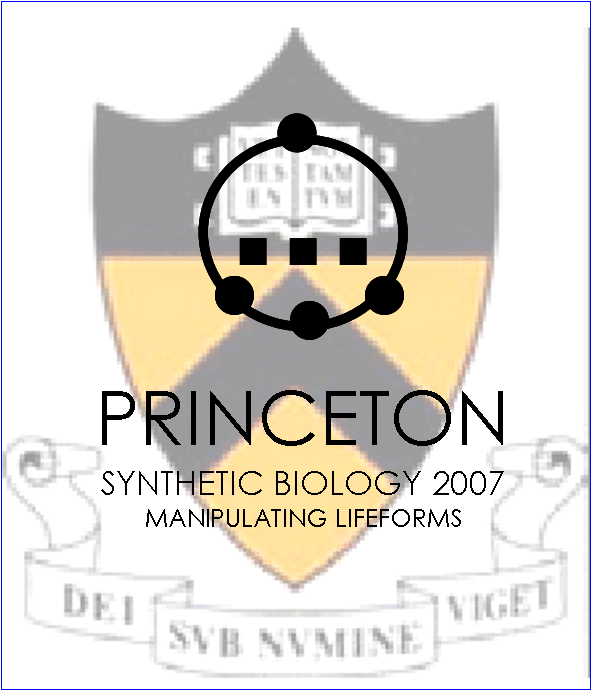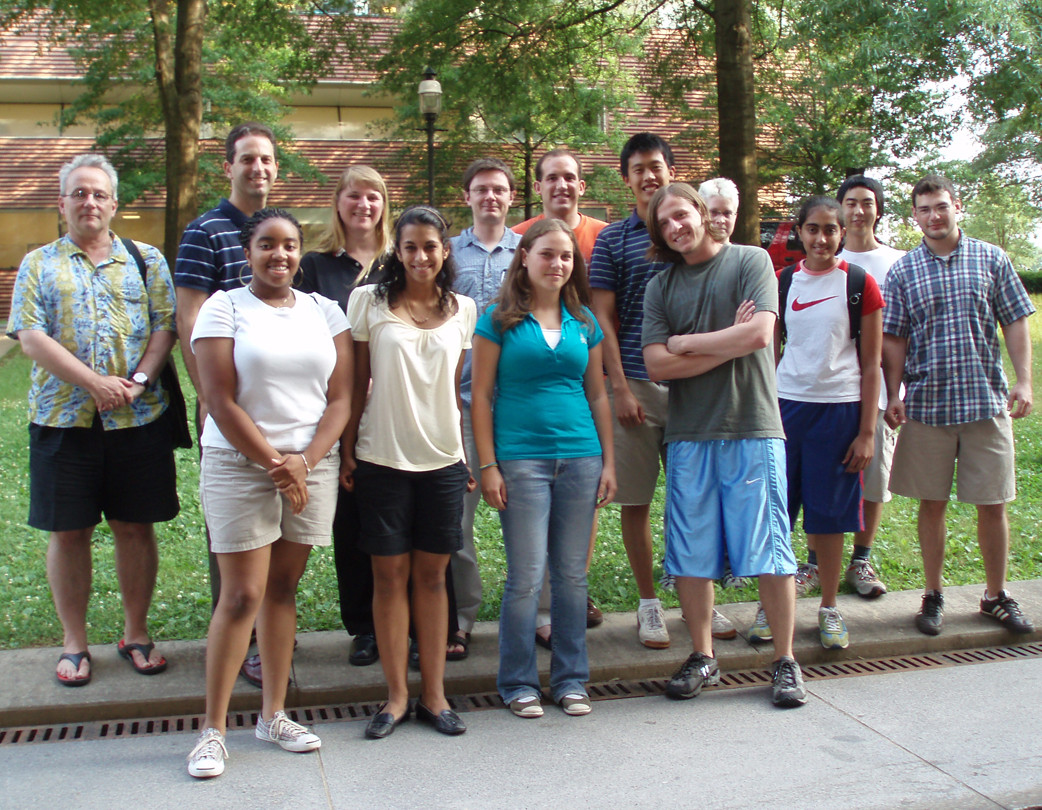Princeton
From 2007.igem.org
| (24 intermediate revisions not shown) | |||
| Line 1: | Line 1: | ||
__NOEDITSECTION__ | __NOEDITSECTION__ | ||
__NOTOC__ | __NOTOC__ | ||
| + | <center>[[Image:PrincetonLogo2007.png|400x400px| 2007 logo]] [[Image:GroupPictureSmallcropped.jpg|750x400px|Group picture]]<br><br> | ||
| - | =Princeton | + | {| cellspacing="2px" cellpadding="0" border="2" style="padding: 0; width: 900px; color: #000000; background-color: #999999;" |
| + | | width=717px style="padding: 10px; background-color: #ffffaa; border: 2px solid #993300;" | | ||
| + | =[[Princeton/Project Description | An RNAi-Enhanced Logic Circuit: Cancer-Specific Detection and Destruction]]= | ||
| - | + | The [[Princeton/People | Princeton University iGEM 2007 team]], consisting of 10 undergraduate students, 2 high school students, and 7 instructors, envisions a paradigm shift in the way one can target cancer and destroy the resulting cancerous cells. | |
| - | + | ||
| - | + | Using standard engineering practices, we have designed, and are in the process of implementing, a novel system that utilizes RNA interference (RNAi) to detect and destroy cancer cells in a tissue-specific manner. We are interfacing RNAi components together with promoter and repressor elements to form logic circuits, which allow the use of multiple criteria to target cancerous cells in a unique and highly specific manner. As a measure of safety, we utilize mutant lentiviral integrase to deliver our construct into the cell as a non-integrated plasmid, preventing any disruptive effects that could be attributed to pseudorandom integration by the lentivirus. This also ensures that the daughter cells will not inherit the cancer-detecting circuitry, thus preventing unintended proliferation of our construct and allow for more extensive and comprehensive cancer treatments. We have constructed many components of our system and are in the process of testing our plasmids in a proof of concept manner. Where possible, we will revise and improve upon our components based on mathematical modeling and experimental results. | |
| - | === | + | Please see the [[Princeton/overview | extended overview]] for more information. |
| - | + | |} | |
| + | {| cellspacing="2px" cellpadding="0" border="2" style="padding: 0px; width: 750px; color: #000000; background-color: #999999;" | ||
| + | |-valign="top" | ||
| + | |width=179.25px style="padding: 5px; background-color: #ffffaa; border: 2px solid #993300;" | | ||
| + | <h3>Team Members</h3> | ||
| - | [[ | + | *[[user:asichel|Andrew Sichel]] |
| + | *[[user:aswamina|Aparna Swaminathan]] | ||
| + | *[[user:btsui|Bambi Tsui]] | ||
| + | *[[user:cdehart|Caroline DeHart]] | ||
| + | *[[user:dcooper|Devin Cooper]] | ||
| + | *[[user:jmonk|Jon Monk]] | ||
| + | *[[user:jchiu|Justine Chiu]] | ||
| + | *[[user:katias|Katia Sherman]] | ||
| + | *[[user:kmangal|Kush Mangal]] | ||
| + | *[[user:nyuan|Neal Yuan]] | ||
| + | *[[user:pcowgill|Paul Cowgill]] | ||
| + | *[[user:vichij|Vichi Jagannathan]] | ||
| - | == | + | |width=179.25px style="padding: 5px; background-color: #ffffaa; border: 2px solid #993300;" | |
| - | + | ||
| - | + | ||
| - | + | ||
| - | + | ||
| - | + | ||
| - | + | ||
| - | + | ||
| - | + | ||
| - | + | ||
| - | + | <h3>Instructors</h3> | |
| - | + | ||
| - | + | ||
| - | + | ||
| - | + | ||
| - | + | ||
| - | + | ||
| - | + | ||
| - | + | ||
| - | + | ||
| - | + | ||
| - | + | ||
| - | + | ||
| - | == | + | *[[user:rweiss|Ron Weiss]] [mailto:rweiss@princeton.edu Contact Ron] [http://www.princeton.edu/~rweiss Website] |
| + | *[[user:Cil|Cil Purnick]] [mailto:ppurnick@princeton.edu Contact Cil] | ||
| + | *[[user:ilemisch|Ihor Lemischka]] [http://directory.mssm.edu/faculty/facultyInfo.php?id=43268&deptid=92 Website] | ||
| + | *[[user:cry707|Christoph Schaniel]] [http://directory.mssm.edu/faculty/facultyInfo.php?id=43270&deptid=92 Website] | ||
| + | *[[user:pguye|Patrick Guye]] | ||
| + | *[[user:eskamoah|Noah Davidsohn]] | ||
| + | *[[user:saurabhg|Saurabh Gupta]] | ||
| - | + | <h3>Resources</h3> | |
| + | [[Princeton/literature | Literature on RNAi and Cancer]] | ||
| - | [[ | + | <h3>Pictures</h3> |
| + | [[Princeton/People | Our happy team]] | ||
| - | + | |width=179.25px style="padding: 5px; background-color: #ffffaa; border: 2px solid #993300;" | | |
| + | <h3>Overview</h3> | ||
| + | [[Princeton/overview | Our Project]] | ||
| + | <h3>Lab Work</h3> | ||
| + | [[Princeton/lab | Lab work]] | ||
| - | + | <h3>Research</h3> | |
| + | [[Princeton/lab/experimentation | Experimentation]] | ||
| + | |||
| + | <h3>Bioinformatics</h3> | ||
| + | [[Princeton/lab/bioinformatics | Bioinformatics]] | ||
| + | |||
| + | <h3>Simulations</h3> | ||
| + | [[Princeton/lab/simulation | Simulations]] | ||
Latest revision as of 03:48, 27 October 2007


An RNAi-Enhanced Logic Circuit: Cancer-Specific Detection and DestructionThe Princeton University iGEM 2007 team, consisting of 10 undergraduate students, 2 high school students, and 7 instructors, envisions a paradigm shift in the way one can target cancer and destroy the resulting cancerous cells. Using standard engineering practices, we have designed, and are in the process of implementing, a novel system that utilizes RNA interference (RNAi) to detect and destroy cancer cells in a tissue-specific manner. We are interfacing RNAi components together with promoter and repressor elements to form logic circuits, which allow the use of multiple criteria to target cancerous cells in a unique and highly specific manner. As a measure of safety, we utilize mutant lentiviral integrase to deliver our construct into the cell as a non-integrated plasmid, preventing any disruptive effects that could be attributed to pseudorandom integration by the lentivirus. This also ensures that the daughter cells will not inherit the cancer-detecting circuitry, thus preventing unintended proliferation of our construct and allow for more extensive and comprehensive cancer treatments. We have constructed many components of our system and are in the process of testing our plasmids in a proof of concept manner. Where possible, we will revise and improve upon our components based on mathematical modeling and experimental results. Please see the extended overview for more information. |
Team Members |
Instructors
ResourcesPictures |
OverviewLab WorkResearchBioinformaticsSimulationsSimulations |